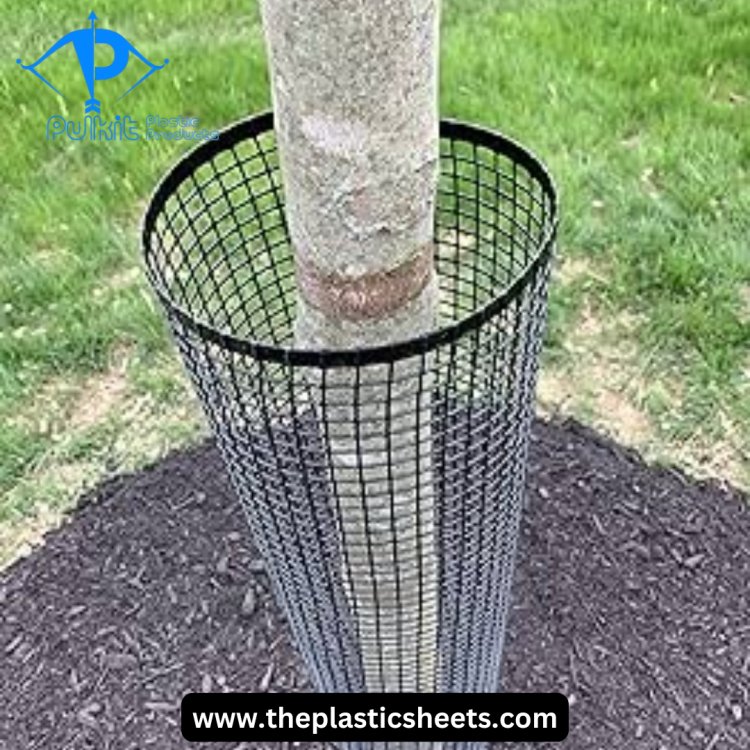Plastic Tree Guards: Protecting and Supporting Tree Growth

Tree planting is vital for the environment, contributing to improved air quality, enhanced biodiversity, and reduced erosion. However, newly planted saplings face a range of threats, including damage from animals, harsh weather conditions, and human activities. One effective way to protect young trees is by using plastic tree guards. These simple yet effective tools shield saplings during their early stages of growth, ensuring they have a better chance to thrive. In this article, we Pulkit Plastic Products explore the benefits, uses, types, and installation of plastic tree guards, and also address frequently asked questions (FAQs) to help you understand their importance in supporting healthy tree growth.
What Are Plastic Tree Guards?
The Tree Guard Wrap Plastic are cylindrical protective coverings made from durable, weather-resistant plastic materials designed to wrap around young trees or saplings. They act as a barrier against physical damage from external sources such as grazing animals, lawnmowers, and wind, while also providing a microclimate that can aid in the early growth stages of the tree.
These guards come in various sizes and designs, depending on the tree species, environmental conditions, and specific threats the tree may face. By offering protection, tree guards increase the survival rate of saplings, which is particularly crucial in reforestation, landscaping, and farming efforts.
Why Use Plastic Tree Guards?
Plastic tree guards offer a range of benefits, which makes them an essential tool for those looking to protect and nurture trees. Here are some key reasons to consider using them:
-
Protection Against Animals: Deer, rabbits, and other grazing animals often feed on young shoots and leaves, which can stunt or even kill young trees. Plastic tree guards form a physical barrier around the trunk and lower branches, preventing animals from causing damage.
-
Wind and Weather Protection: Newly planted saplings are particularly vulnerable to strong winds, frost, and fluctuating weather conditions. Plastic guards provide a buffer against the wind and can help reduce the damage caused by freezing temperatures.
-
Preventing Mechanical Damage: Lawn equipment such as weed trimmers and lawnmowers can easily damage or strip the bark off young trees. Tree guards act as a shield, ensuring that machinery doesn’t come into direct contact with the tree.
-
Improving Microclimate: Tree guards create a slightly warmer and more humid microclimate around the sapling, which can promote faster and healthier growth. This is especially beneficial in colder climates or during early spring and late fall.
-
Reduced Herbicide Damage: In agricultural and landscaping environments, the use of herbicides can inadvertently affect nearby saplings. Tree guards help shield the saplings from accidental herbicide exposure, keeping them safe and healthy.
-
Support Growth of Straight Trunks: In addition to providing protection, plastic tree guards can encourage the growth of straight trunks, which is desirable for many types of trees, especially those grown for timber or aesthetic purposes.
Types of Plastic Tree Guards
Plastic tree guards come in a variety of designs, each suited to different needs and applications. Below are some common types of tree guards:
-
Spiral Tree Guards: Spiral tree guards are made from flexible plastic and can be wound around the sapling's trunk. They are easy to install and adjust as the tree grows, making them popular for small-scale tree planting projects. The spiral design allows for air circulation while offering protection.
-
Mesh Tree Guards: These guards are made from a plastic mesh material and are usually formed into a cylinder around the sapling. Mesh guards provide good air and light flow while keeping animals at bay. They are often used in areas where wildlife browsing is the primary concern.
-
Solid Tubular Tree Guards: Solid tree guards are rigid plastic tubes placed around the sapling. These are especially useful for protecting trees in environments prone to mechanical damage from lawn equipment. They also provide excellent weather and animal protection but might require removal or adjustment as the tree grows larger.
-
Biodegradable Tree Guards: While traditional plastic guards offer long-term protection, biodegradable options are becoming increasingly popular. These are designed to break down over time, reducing plastic waste while still offering protection during the critical early growth stages.
How to Install Plastic Tree Guards
Installing Plastic Tree Guard Manufacturer is a straightforward process, but proper installation is key to ensuring they effectively protect the tree without hindering its growth. Here's a step-by-step guide:
-
Choose the Right Guard: Depending on the tree's size, the surrounding environment, and the specific threats (animals, wind, machinery), select the most appropriate type of plastic tree guard.
-
Secure the Guard Around the Tree: Wrap the tree guard around the sapling’s trunk, ensuring that it covers the tree from the base to a few inches above the highest potential threat, such as grazing height for animals. For spiral or mesh guards, simply twist or clip the guard into place.
-
Stake if Necessary: For larger or solid tubular guards, you may need to stake the guard to ensure it stays upright and stable. Use a wooden or metal stake, and secure the guard to the stake with ties or fasteners.
-
Leave Room for Growth: Ensure the tree guard is not too tight around the tree, as the sapling will need space to grow. Some guards are designed to expand or can be removed and replaced as the tree grows larger.
-
Monitor Regularly: Periodically check the tree guard to ensure it is still in place and that the tree is growing healthily. Adjust or remove the guard if it begins to impede growth.
Benefits of Using Plastic Tree Guards
Using plastic tree guards brings numerous advantages to anyone involved in tree planting or forestry projects. Here are some of the most notable benefits:
-
Increased Sapling Survival Rates: Plastic tree guards significantly boost the chances of survival for young trees, especially in areas with high wildlife activity or adverse weather conditions.
-
Cost-Effective Solution: Plastic tree guards are affordable and easy to install, making them a practical choice for large-scale planting projects or small garden plots.
-
Long-Lasting Protection: Made from durable materials, plastic tree guards can last for years, providing ongoing protection as the tree grows.
-
Environmental Stewardship: By protecting young trees, tree guards play a crucial role in supporting reforestation and landscaping efforts, which in turn contribute to the overall health of the environment.
Conclusion
The Plastic Tree Guard Price are a simple yet effective way to protect young trees from a variety of external threats. Whether you are planting trees in a rural, urban, or agricultural environment, these guards offer the necessary protection to give your saplings the best chance to grow strong and healthy. From preventing damage caused by animals and weather to ensuring straight, healthy trunks, plastic tree guards are an essential tool for anyone involved in tree planting projects. By choosing the right type and properly installing them, you can ensure the longevity and health of your trees, contributing to a greener, healthier environment.
Frequently Asked Questions (FAQs)
1. How long should I keep the tree guard in place?
Tree guards should be kept in place for the first few years of the sapling’s life until it is strong enough to withstand external threats. Typically, guards can be removed after 2-5 years, depending on the growth rate of the tree.
2. Can plastic tree guards harm the tree?
If properly installed and monitored, tree guards should not harm the tree. However, if left unchecked, they could restrict growth. It's important to periodically check the guard to ensure it is not too tight as the tree expands.
3. Are plastic tree guards environmentally friendly?
While traditional plastic guards are durable and long-lasting, they do pose a waste problem if not properly disposed of. Biodegradable options are available for those looking for a more environmentally friendly solution.
4. Can I reuse plastic tree guards?
Yes, plastic tree guards can be reused for multiple planting cycles, making them a cost-effective and sustainable option for tree protection.
















